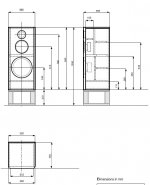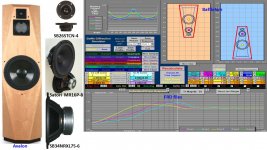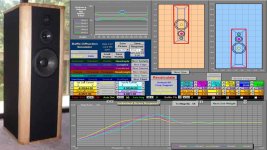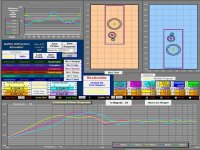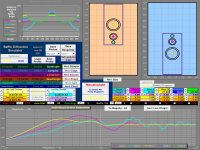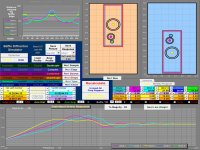Along the lines of a Spendor BC1 or SP1/2 or Harbeth Monitor 30 etc
Are there any good examples of builds like these?
Are there any good examples of builds like these?
From a classic point of view, such as the BC1, this speaker is only a three way due to the limitations of the main tweeter used.
The Celestion tweeter couldn't go particularly low, neither did it extend particularly high, needing a super tweeter to fill in the top octave.
These days tweeters can do both, go lower and go to 20kHz. This negates the need for the super tweeter and the associated problems with using it - ie additional phase shifts and interference/lobing issues.
Basically there's no benefit to doing this kind of thing, just downsides. It was necessary then, but not any more.
From the point of view of a modern take on this approach you'd be looking at a three way design using a 2" midrange dome. Crossing at say 800Hz and 3kHz.
The Celestion tweeter couldn't go particularly low, neither did it extend particularly high, needing a super tweeter to fill in the top octave.
These days tweeters can do both, go lower and go to 20kHz. This negates the need for the super tweeter and the associated problems with using it - ie additional phase shifts and interference/lobing issues.
Basically there's no benefit to doing this kind of thing, just downsides. It was necessary then, but not any more.
From the point of view of a modern take on this approach you'd be looking at a three way design using a 2" midrange dome. Crossing at say 800Hz and 3kHz.
From a classic point of view, such as the BC1, this speaker is only a three way due to the limitations of the main tweeter used.
The Celestion tweeter couldn't go particularly low, neither did it extend particularly high, needing a super tweeter to fill in the top octave.
These days tweeters can do both, go lower and go to 20kHz. This negates the need for the super tweeter and the associated problems with using it - ie additional phase shifts and interference/lobing issues.
Basically there's no benefit to doing this kind of thing, just downsides. It was necessary then, but not any more.
From the point of view of a modern take on this approach you'd be looking at a three way design using a 2" midrange dome. Crossing at say 800Hz and 3kHz.
Thank you very much for your insight 5th element. I guess what I really want is something like a Harbeth 40.2 but I do see the value in a 30.2 which is a two way design.
With a 3 way I want a something with a 10-12” woofer, a 6-7” mid and a tweeter.
That would give me the lower end I want and then a more normal 2 way on top. I prefer not to use a really big mid-woofer but Harbeth uses almost an 8” in the 30.2
So perhaps a more modern take on the old BBC designs.
Thanks again for your comment.
Not exactly the look, cabinet wise, I am looking for but I bet it sounds right.
Check out troels gravessen 3 way classic designs. These might suit your needs.
I will and thank you.
Along the lines of a Spendor BC1 or SP1/2 or Harbeth Monitor 30 etc
Are there any good examples of builds like these?
Hello,
I have the same question of a friend of me to design such classical three way. I already have some ideas on paper how it will look like.
I will use the 11 inch Eton 11-212 in closed box, the 6.5 inch Accuton C173-6-096E and the Seas Be tweeter E0058. Crossover at 300 and 2000 Hz. I will make a digital filter with miniDSP for it.
If you are interested in, I can design a passive filter for it. For me it is always interesting to have some feedback of practical realizations of such designs.
In attachement the first drawings of the cabinet.
Paul
Attachments
Last edited:
MiniDSP cannot correct baffle edge diffraction effects and the room-wall sound reflections which are generated. Edge Bevels and Rounds. Tweeter off-center mounting. If cabinet construction extremes like the Avalon bevels or large radius quarter round edges do not fit your style, modest radius edge rounds plus center offset of the midrange and tweeter are a decent diffraction solution. In Zaph's cabinet construction, note how driver offset allows a simple angled internal board to create a tapered rear volume behind the midrange which will reduce resonances.
Attachments
Stephen and Paul, The attached baffle diffraction sims of (basic box) and (TM offset+1" bevels) might influence your cabinet build.
ported 12" example:
The SB_Acoustics 12" woofer SB34NRXL75-8 sims to SPL=91db sensitivity with -F3=38Hz in a 2.1cuft ported volume.
sealed 12" example:
The SB_Acoustics 12" woofer SB34NRX75-6 sims to SPL=88 sensitivity with -F3=37Hz in a sealed 4cuft box. Many favor sealed-box woofer transients, and the ease of electronic bass equalization, but it requires ~2x the box volume.
ported 12" example:
The SB_Acoustics 12" woofer SB34NRXL75-8 sims to SPL=91db sensitivity with -F3=38Hz in a 2.1cuft ported volume.
sealed 12" example:
The SB_Acoustics 12" woofer SB34NRX75-6 sims to SPL=88 sensitivity with -F3=37Hz in a sealed 4cuft box. Many favor sealed-box woofer transients, and the ease of electronic bass equalization, but it requires ~2x the box volume.
Attachments
Hi Linesource,
Thanks for the information. I still have to do an analysis in Leap for the vertical position of the drivers.
In Leap polar responses can be observed, and normalized to the on-axis response, it gives a good view.
I prefer the drivers horizontal in the middle for a symmetric horizontal dispersion. Applying 1" bevels for sure.
Placing the tweeter close to a flat top panel is not recommended.
The horizontal polar response will be strongly affected at a few kHz, with a frequency response dip on axis.
The cabinet shapes of the Magico speakers behave very well in simulation.
Their front panel is rounded smoothly to the sides and they never place the tweeter close to the top. In some of their speakers even the midrange on the top.
For the woofer, the Eton 11-212 is also an interesting one. It can already be used in 50 litres (1.8cuft) closed box.
Then the fc = 43 Hz and Qtc = 0.57. With some serial resistance of the passive filter coils, Qtc becomes around 0.67.
Indeed, the 12" SB34NRX75-6 for closed box needs a lot of volume, because the Qts is already 0.4 and the Vas is 260 L.
And I prefer closed box for this speaker.
Thanks for the information. I still have to do an analysis in Leap for the vertical position of the drivers.
In Leap polar responses can be observed, and normalized to the on-axis response, it gives a good view.
I prefer the drivers horizontal in the middle for a symmetric horizontal dispersion. Applying 1" bevels for sure.
Placing the tweeter close to a flat top panel is not recommended.
The horizontal polar response will be strongly affected at a few kHz, with a frequency response dip on axis.
The cabinet shapes of the Magico speakers behave very well in simulation.
Their front panel is rounded smoothly to the sides and they never place the tweeter close to the top. In some of their speakers even the midrange on the top.
For the woofer, the Eton 11-212 is also an interesting one. It can already be used in 50 litres (1.8cuft) closed box.
Then the fc = 43 Hz and Qtc = 0.57. With some serial resistance of the passive filter coils, Qtc becomes around 0.67.
Indeed, the 12" SB34NRX75-6 for closed box needs a lot of volume, because the Qts is already 0.4 and the Vas is 260 L.
And I prefer closed box for this speaker.
- Status
- Not open for further replies.
- Home
- Loudspeakers
- Multi-Way
- Looking for a classic British 3 way design
